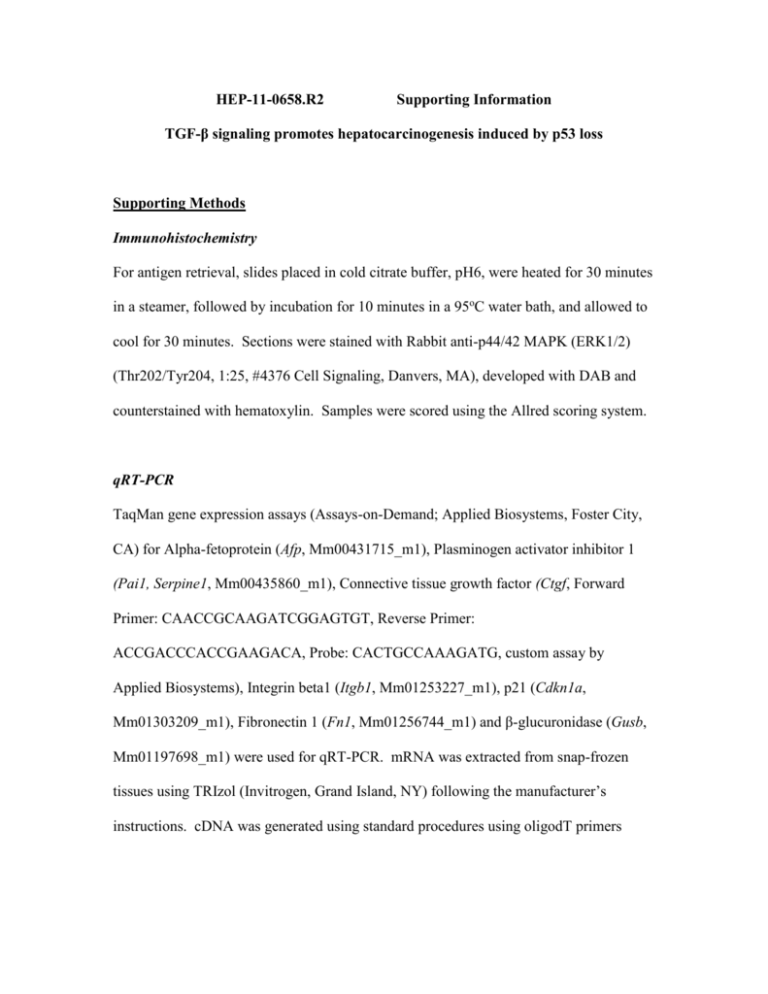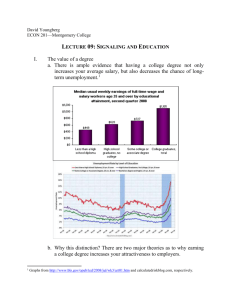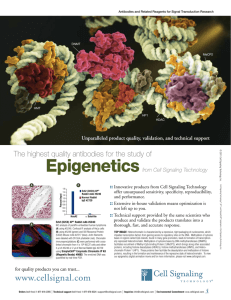HEP_24653_sm_SuppInfo
advertisement

HEP-11-0658.R2 Supporting Information TGF-β signaling promotes hepatocarcinogenesis induced by p53 loss Supporting Methods Immunohistochemistry For antigen retrieval, slides placed in cold citrate buffer, pH6, were heated for 30 minutes in a steamer, followed by incubation for 10 minutes in a 95oC water bath, and allowed to cool for 30 minutes. Sections were stained with Rabbit anti-p44/42 MAPK (ERK1/2) (Thr202/Tyr204, 1:25, #4376 Cell Signaling, Danvers, MA), developed with DAB and counterstained with hematoxylin. Samples were scored using the Allred scoring system. qRT-PCR TaqMan gene expression assays (Assays-on-Demand; Applied Biosystems, Foster City, CA) for Alpha-fetoprotein (Afp, Mm00431715_m1), Plasminogen activator inhibitor 1 (Pai1, Serpine1, Mm00435860_m1), Connective tissue growth factor (Ctgf, Forward Primer: CAACCGCAAGATCGGAGTGT, Reverse Primer: ACCGACCCACCGAAGACA, Probe: CACTGCCAAAGATG, custom assay by Applied Biosystems), Integrin beta1 (Itgb1, Mm01253227_m1), p21 (Cdkn1a, Mm01303209_m1), Fibronectin 1 (Fn1, Mm01256744_m1) and β-glucuronidase (Gusb, Mm01197698_m1) were used for qRT-PCR. mRNA was extracted from snap-frozen tissues using TRIzol (Invitrogen, Grand Island, NY) following the manufacturer’s instructions. cDNA was generated using standard procedures using oligodT primers (Invitrogen). The assays were performed using either the Bio-Rad Opticon 2 or the BioRad CFX96 real-time PCR systems (Bio-Rad, Hercules, CA). Tissue Lysis Buffer Triton X-100 Lysis Buffer [1% Triton X-100 (J.T. Baker, Phillipsburg, NJ), 50mM TrisHCl pH 7.4 (Fisher Scientific, Pittsburgh, PA), 150 mM NaCl (Fisher Scientific), 50 mM β glycerophosphate (MP Biomedicals, LLC, Solon, OH), 10% glycerol (Fisher Scientific), 2 mM EDTA (GIBCO/Invitrogen)] supplemented with a cocktail of protease (Roche, Indianapolis, IN) and phosphatase (Sigma-Aldrich, St. Louis, MO) inhibitors. Antibodies The following primary antibodies were used for Western blot analysis: Rabbit antiglyceraldehyde-3-phosphate dehydrogenase (GAPDH) conjugated to horseradish peroxidase (HRP) (1:10,000, #3683 Cell Signaling), Rabbit anti-Phospho-Smad2 (Ser465/467, 1:1000, #3101 Cell Signaling), Rabbit anti-Phospho-Smad3 (Ser423/425, 1:1000, #9520 Cell Signaling), Rabbit anti-Smad2/3 (1:1000, #3102 Cell Signaling), Rabbit anti-p44/42 MAPK (ERK1/2) (1:1000, #9102 Cell Signaling), and Rabbit antiphospho-p44/42 MAPK (ERK1/2) (Thr202/Tyr204, 1:2000, #4370 Cell Signaling). The following secondary antibody was used: Goat anti-Rabbit IgG-HRP (1:5000, #SC-2004, Santa Cruz Biotechnology, Inc., Santa Cruz, CA). Supporting Figures Supporting Figure 1. Recombination and deletion of Trp53 and Tgfbr2 in normal liver and tumors. Specific PCR assays were used to detect the Alb-Cre transgene, the wild-type (Trp53wt) or floxed (Trp53flx) Trp53 allele, or the wild-type (Tgfbr2wt) or floxed (Tgfbr2flx) Tgfbr2 allele. These results demonstrate liver specific recombination of Trp53 and Tgfbr2 in the presence of Alb-Cre. Supporting Figure 2. Phospho-Smad2 expression in normal and liver tumor tissue. Upper panel, Analysis of Phospho-Smad2 expression by Western blot demonstrates an increase in phospho-Smad2 in tumors (T) from both Trp53KO and Trp53KO;Tgfbr2KO mice. Middle panel, Total Smad2 levels. Lower panel, GAPDH control. Supporting Figure 3. Phospho-ERK1/2 expression. Phospho-ERK1/2 expression was determined by immunohistochemical analysis. Additional representative photomicrographs are shown. (A) HCC, 40x and (D, G) CC from Trp53KO;Tgfbr2KO mice, 40x. (B, C) HCC, 40x and (E, F, H) CC from Trp53KO mice, 40x. Arrows indicate increased phospho-ERK1/2 in adjacent liver tissue.







